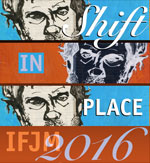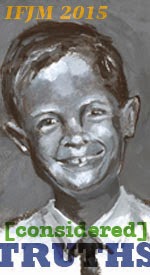
Above: my 2010 fake journal on April 15, halfway through the process. More about what is happening to it in the post below. Click on the image to view an enlargement.
As you can see from the above photo, by April 15 my fake journal was curling up at an amazing angle. Additionally things were getting tight at the spine of this simple, sewn pamphlet (an APICA commercially made soft-covered notebook which I have written about before).
For many journal keepers the journal's final aspect—whether it looks worn or brand new—is important. Fake journaling can help you bust out of your prejudices as to whether or not there is a "right way" for something to happen, or whether there is a right way for something to end up looking.
Often people come to visual journaling with the idea that their filled journal should be (must be) a publishable piece of artwork—rather than whatever it turned out to be.
Imposing such restrictions on yourself can be limiting, even crippling to your journal practice. You allow your internal critic free-reign and constant access to weigh in on any of your activities—he gets to micro-manage your choices. You might put off working in your journal because you don't feel well or you don't think you have enough time to do something that is "worthy." You might actually find yourself thinking about "worthy" all the time—I've seen this happen. (Just the other day a friend told me she finally felt worthy to work in a journal I'd given her made with wonderful paper. I wanted to scream. Happily she feels worthy now, but the book has needed to be worked in all this time—books need to be filled.)
Sure there are artists creating journals that delight the eye and intellect so much that every page should be published. But if you look at the work of those artists you'll see that it is wonderful because they aren't hampered by preconceived notions of what they are "going for" but instead are simply working.
I would love to paint like Gérôme but life intervened and I made other choices and I didn't work as hard as he did, and frankly don't have the natural talent. I can be a realist about it. And because I can be a realist about that I can also be busy in my journal working from the point where I am at this point in my life.
This is something to keep in mind when you look at the journals of artists you admire—they are at a different point than you are, in skill, in talent, in interest, in work ethic, in circumstances you can't even begin to imagine. All of this plays into how their journals look at any given time.
The journals that I really admire are filled with pages of risk taking—risks that pay off because the artists are skilled, but risk taking all the same—which could result in failure. Embracing risk is part of making art, whether you are doing something to publish or not.
So my tip today, as we hit the final stretch in 2010's celebration of International Fake Journal Month is: embrace all the chaos and risk that comes your way while creating your fake journal.
For me this year, the scope of the journal was different from any journal I've done for myself. I have only been using pencil (something I haven't done since college) and my journal author has been using paper inserts in a way that I wouldn't do in a regular journal without making compensations (i.e., cutting out other pages to make space for the insertions).
The result is a physical object which is warping in a way I had not expected (though if I'd thought about it at all before hand I should have realized this would happen) and has caused me to further let go of my "fussy" procedures as to cutting and gluing. The second half of the book is really about "making it work" rather than getting it to work in the most optimal way. (And the great thing about it being a fake journal is that the author has to make it work, not me, and she doesn't seem to mind at all, so that's good role modeling for me!)
By embracing the "chaos" of this approach in this particular journal I'm able to whittle away at my own particular "optimal way" mentality. It doesn't mean I will stop being someone interested in experimenting and finding optimal ways to do things in my journal, and with the art materials I elect to use. What it does mean, however, is that I can free myself from the need to find the optimal way all the time. I can step away from "optimal way" when that means getting onto a more useful path to creation. That's always a good thing.
For me, over the years, that has been one of the most striking benefits of fake journaling. Last year's use of an Alvin Field Book, dip pen, and watercolor helped push me back into non-archival materials like school notebooks (something I used throughout my childhood). It has freed me even more from "archival" materials. It's great to use archival materials; it's great to work in journals that I have bound myself with archival materials; but fake journaling reminds me that it is simply just great to be journaling, with whatever is at hand.
For someone of opposite tendencies fake journaling might be a time to trot out the specially made journal with archival pages…
As you move through the final days of this year's celebration I hope that you find a way to embrace the oddities, the risks, the less-than-you-had-hoped-for results that may have happened. Own them as part of the journey you're on to express your vision. Use the accidents and mishaps to encourage you to more experimentation, rather than allow them to shut down your creative experimentation.
When we were young and we played, we don't get graded on the quality of our play (unless you played with a really bossy child or an absurdly intrusive adult); your passing or excelling "grade" in play was the feeling you got—the satisfaction you had—in knowing that you were really engaged. That's what matters. Remember that, and bring it forward into your journal practice.
Let your journal (fake or real) be a record of your play and experimentation. Enjoy the satisfaction of being fully engaged.











No comments:
Post a Comment